Hide
Alderney
hide
Hide
hide
Hide
Hide
Hide
"Alderney is about 8 miles in circumference. It lies the nearest to Normandy, and is remarkable for its Strait, called the Race, so fatal to shipping. It is famous for its cows."
from Grose's 'The Antiquities of England and Wales', 1777
Hide
Note that Alderney is part of the Bailiwick of Guernsey and so much of the Guernsey page is relevant.
Alderney Parishes
Alderney has a single parish with its church dedicated to St Anne
St. Anne's Church, Alderney
In the old cemetry stood the chapel built in the seventh century by the disciples of St. Guernole, Abbot of Landevennec, near Brest in France, the Christian that brought the glad tidings to Alderney. His doctrines were the same as those preached by St. Sampson and his two cousins. Afterwards, probably in the 12th or 13th Century, a new chapel was built on the same site, which, according to the plan kept in the parish church, must have been originally similar to St. Apolline in Guernsey and the Fisherman's Chapel in Jersey. The North transept was added in 1561 and the square tower at the east end in 1767 when the windows were altered. All that remains of this church is the tower, now the clock-tower of the town. Rev. John Le Mesurier, son of the last hereditary governor of the Island, built in 1850 the present church, and made a free gift of it to the parish, along with an annual endowment of £150 for the curate. The architect was Sir G. Scott. The handsome granite gateway of the entrance to the cemetry bears the inscription - “Albert 1864. Erected by the people of Alderney” to commemorate his visit.
Anon. Late 19th Century Manuscript - courtesy of Orinda Spence
Hide
Guernsey, Alderney and Sark are included in the decennial (1841 onwards) Census for England and Wales and can be found online, see the GENUKI ENG+WAL Census page.
Anglican
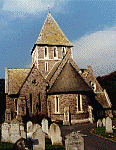 The 'new' St Anne's Church (built 1850) - only the clock tower and cemetery remain of the original parish church.
The 'new' St Anne's Church (built 1850) - only the clock tower and cemetery remain of the original parish church.
The Church of St Anne: Baptisms 1662-1902 with annotations copied from an earlier (missing) book commenced in 1628. 1902 to present day in Church only. Deaths from drowning and Burials 1652 to 1863. Succeeding Registers lost during the Occupation. Marriages from 1657-1886.
The Priaulx Library, in Guernsey, have photocopies of Baptisms 1822-1832, Private Baptisms 1819-1821. Burials 1809-1812, 1853-59. Marriages 1841-1886 .
Non-Conformists
Catholic Church of St Anne & St Mary Magdalene: Baptisms March 1849-Oct 1952. Deaths January 1859 to April 1940 and two entries in 1946. Marriages from February 1852 to July 1924.
Methodist (English and French) and Presbyterian Church records prior to 1945 were destroyed during the Occupation.
Births, Deaths from 1850, Marriages from 1886
The Greffier, Registry for Births, Deaths, Companies, Land and Marriages, St Anne, Alderney GY9 3AA is custodian but all enquiries will be sent to Mrs Mignot (below).
Births from 1850 - missing May 1871-Dec. 1874 There is a hand-ruled book of declarations, from August 1850 to December 1874, that can be used to fill this gap. Deaths from August 1850-1855, 1907 onwards. Hand-ruled book of declarations from October 1855 to December 1874. Gap 1875-1907. Marriages from 1886 (from St Anne's Church). 1891 onwards from elsewhere on the Island.
Births, Deaths and Marriages from 1925 to date only
H.M. Greffier, The Royal Court House, St Peter Port, Guernsey GY1 2PB. Telephone (01481) 725277. Office Hours 9.00 a.m.to 5.00 p.m - personal visits 2.00-4.00 p.m. only - £1 admission to Strong Room.
The Priaulx Library, in Guernsey, have incomplete microfilmed sets of Civil Registration records. Alderney Greffe Records - Births July 1850-July 1857, July 1857- July 1860, July 1860-August 1885. Deaths 1850-1855, 1907-1925.
The Church and Town of St Anne from Louisa Lane Clarke's 'Alderney Guide' (1851): 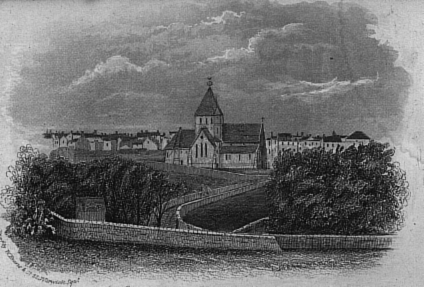 St Anne, the centre for Alderney's population, is located slightly to the north west of the centre of the island on high ground.
St Anne, the centre for Alderney's population, is located slightly to the north west of the centre of the island on high ground.
The new church of St Anne was built in 1850 at the personal expense of the Rector Rev. John Le Messurier. It would appear to be much larger than was needed but also had to accomodate the Garrison. The old church had become decrepid and it was said that, with the growth of dissenting religions and the foundation of several chapels for their use, the Anglican Church in danger of being deserted altogether. The building was demolished, leaving only the clock tower standing. Picture at The Alderney Society and Museum.
The old Church and Parsonage in 1830: 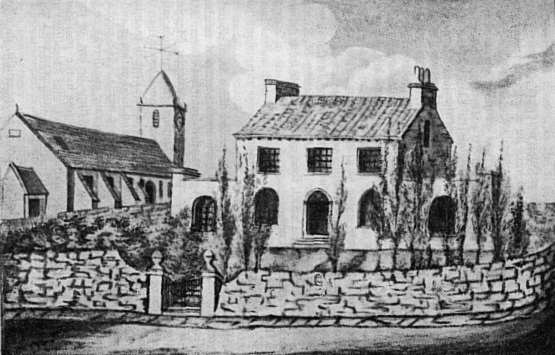
The Alderney Commercial Directory of 1851
From 'The Alderney Guide' by Louisa Lane Clarke - courtesy of the Société Jersiaise Library
Academies and Schools Parish Church Schools Henry H. Langstaff, of St. John's College, Battersea, master, High-street. Misses Le Lievre, High street Mrs. Todd, Braye. Agents, Fire and Life Peter Mesny, Hurel. N. B. Le Bair, St Martin's. Auctioneer John Tourtel, High street. Bakers and Flour Dealers Thomas Des Prés, High street. John Sibert. John Bichard, Grosnez street. Peter Bott, Hurel. Robert Venning, High street. Edward Cottel, Grosnez str. Billiard Room A. De Beuigny, Braye. Blacksmiths John Ozard, Hurel. Peter Sebire, do. Bookseller and Stationer T. F. Harrison, Grosnez street. Boot and Shoe Makers Peter Le Pelley, Grosnez str. Bishop and Son, do. George Drew, do. Williarn Robin, do. Thomas Ryan, do. Peter Le Cocq, High-street. Brazier and Tin Plate Worker William Mew, Grosnez street. Brick Makers and Lime Burners De Jersey & Queripel, Valongi. T. Blondel & Co., Everlasting lane. Brewer - Norton, Hauteville. Butchers Arthur Willis, High street. - Hayward, do. John Gauvain, do. Cabinet Maker James Grieve, High street. Chemist and Druggist F.J. Cottel, Grosnez street. Carpenters John Blondel, High street. Nicholas Le Cocq, Bourgage. William Sebire, Hurel. Clothes Salesmen M.& H. Fink, Grosnez-street. M. Levi, do. Coal Merchants N. B. Le Bair, St. Martin's. J. A. Gauvain, Bourgage. John Sauvary, Braye. Custom House Officer M. Kennedy, Grosnez street. Glass, China, and Earthenware Dealers G.H. Guley, Grosnez street. T.F. Harrison, do. John Bichard, do. Grocers and Tea Dealers John Bichard, Grosnez-street. T.F. Harrison, do Edwin Bienvenu, do. Mrs. Lenfestey, do. Francis Ahier, do. Edward Cottel, do. Mary Ann Scott, do. Thomas Des Prés, High street. Thomas Renier, Hurel. Peter Bott, do. Hair Dressers Andros Whicker, Grosnez str. Thomas Robert, do. Hotels and Lodging Houses George Scott, Grosnez street. Mrs. Grout, do. Mrs. Kelleway, High street, Mrs. Baber, St. Martin's. Inns and Public Houses Peter Le Noury, "Manchester Unity," Square. Geo. Williams, " Crown Inn," High street. - LeVallais, "Café Français," High-street. J. Bellam, Grosnez street. Richard Le Sauvage, "Railway Tavern," Braye road. Thomas Jukes, Braye. William Brown, do. Wm. Clarke, "Steam Packet Hotel," Braye. Peter Renier, Mount. James Berry, Longy. Ironmongers Taudevin & McDougall, Gros.nez street. John Bichard, Grosnez.street. William Gallichan, High.str. Linen and Woollen Drapers Abraham Bishop, Grosnez str. Hutchinson and Son, do. News Agent T. F. Harrison, Grosnez street. Medical Profession (Surgeons) Thomas Shorland, High street. Edward Baines, Mouriaux. N.J. Bisson, Grosnez street. Milliners and Dress Makers Mrs. Saunders, Grosnez street. Misses Lihou, do. Plasterers and Bricklayers John Langlois, New street. Thomas Le Cocq, Blaie lane. John Le Cocq, Hauteville. Peter Herivel, Little-street. Printer J.P. Ffrost, Grosnez street. Post Office, High-street John Tilbury, Postmaster. Saddler Daniel Love, Grosnez street. Tailors F. Le Breton, Grosnez street. John Bellam, do M.& H. Fink, do Peter Le Noury, Square. Timber Merchants Gauvain & Le Bair, New str. Tobacco Merchants N.B. Le Bair, St. Martin's. William Robilliard, Butes. Watchmakers John Tilbury, High street. - Martin, Grosnez street.
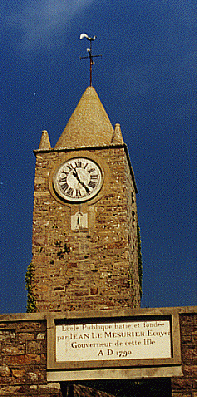
Visit Alderney has pages on various aspects of Alderney History
Right: The clock tower of St Anne and the inscription above the entrance to the Alderney Museum. “Ecole Publique batie et fondée par JEAN LE MESURIER Ecuyer Gouverneur de cette Isle. A.D. 1790.”
Newtown
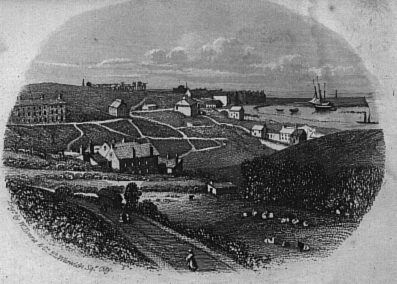
Braye Harbour from Newtown from Louisa Lane Clarke's 'Alderney Guide' (1851)
Braye Harbour is on the north coast and the road that leads from St Anne down to the harbour is the location of Newtown - a small settlement started in 1847 to accommodate the workers brought over by Jackson and Bean to build Alderney's Breakwater. The name indicates something much larger than it actually is.
Braye Harbour and the Breakwater
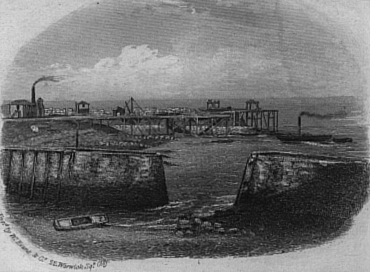
The Government Works in 1851 from Louisa Lane Clarke's 'Alderney Guide'
Construction began in 1847, the intention had been to enclose Braye Bay with two arms. By 1851, the breakwater was beginning to take shape. The works eventually stopped in 1872 and Jackson and Bean moved to Jersey, taking most of their labour force with them.
The Division of Alderney's Common Lands
In 1825 the Le Mesurier family, who had been governors of Alderney for several generations, surrendered their patent to the Crown and left the Island for richer pastures. They left because Alderney was not prospering. Smuggling had all but been stamped out in 1808, the close of the Napoleonic Wars in 1815 dispensed with the need for a British Garrison and privateering ended. The Islanders had become poverty stricken quickly once these sources of revenue had been removed and many were forced from the sea (and other trades) back to the land. However, the growth of the population to around 1,000 during the good times meant that the open field system at La Blaye was no longer enough to feed everyone.
It was soon realised that more agricultural land would be needed to help the Island's fifty two families fend for themselves.
The Guernsey Orders in Council of the period record that on ” the 11th day of June in the year 1823 the inhabitants assembled in the temple at the tolling of the bells at 9 o'clock in the morning in consequence of a Publication made from the Pulpit the preceding Sunday in the customed manner to take into consideration the report of the committee composed of nine persons chosen the 27th of May 1823, from the respectable inhabitants, for the purpose of forming a plan which would be most advantageous for dividing the common lands.”
The land “should be divided equally among the inhabitants great or small without distinction of sex or age”. The vote decided the division should consist of 104 portions, 52 of good land and 52 of inferior. The long standing families were divided up into 50 groups, each nominated one person to draw lots for the good land and inferior land. The left over four lots were to be left for a period of time to allow for late claimants who may have been off the Island when the process began.
The plans finally came before William IV at the Court of St James on August 4 1830 and were refined as follows. The division was agreed and the four remaining lots were to be held for eight months to allow for the 1831 census to be taken and “to give time for those who may have been omitted to come forward.” Left overs were to be at the disposal of the Crown.
Someone was to be named as surveyor and “a book should be kept to be deposited in the Greffe Office to be referred to in future”. Parts to be put aside before the division took place included 100 feet from the highwater mark in the North West from the Clonque to the Manneze for the use of the Militia or any future British Garrison and another area nearby for drying vraic. An area for quarrying was also to be reserved on the south side of the Island.
It was ordered that a copy of the order ” be affixed to the church door for four successive Sundays from completion.” The Royal Court of Guernsey was warned to “allow the names of those born during this period to be added and those who have died to be expunged” with the costs of applications to be born by the Islanders.
A book was indeed made, complete with a full listing of all the families who earned the right to the land and detailed maps of each area. Copies survive in both Alderney (at the The Alderney Society Museum, High Street, Alderney GY9 3TG) and in Guernsey.
The Guernsey copy can be found in one of the large drawers in the Strong Room of the Greffe.
It is entitled “Plans des Communes de l'Ile d'Auregny”. and bears the following inscription on the title page “Copie Authentique du Plan Original qui servira de régle définitive de la repartition des Terres Communes de l'Ile d'Auregny produit le 17 Sept 1831, et sur lequel plan j'ai inscrit les noms des Chefs de chaque division à mesure qu'ils ont eux-mêmes tiré leurs numeros, le tout en conformité à l'ordre de Sa Majestie en Conseil, en date de 4.8.1830.”
Each of the large pages contains a list of named and numbered lots, nineteen people in all are included per lot. The head of household is at the top of the list, wives and families below. Widowed heads of household are indicated. A corresponding map appears opposite with each lot indicated. Areas used for other purposes, for instance the cemetery and the 'Enclos du Ministre' and land reserved for the Government (including the pre-Breakwater Braye Harbour) are indicated.
This is sample from the first page. The two names I had trouble with are marked (?).
Feuille No. 1 Bon Terrain etc. - Lot 1 Joignant au Clos Gan. Samuel Duplain fils Richard Elizabeth Pezet sa femme Richard Duplain son fils Elizabeth Duplain sa fille Jean Duplain son fils Richard Duplain fils Richard Elizabeth Audoire sa femme Thomas Duplain fils Richard Senr. Elizabeth André sa femme Jean fils de Richard Duplain Elizabeth Duplain sa femme Nicolas le Cocq fils de Samuel Marie le Cocq sa femme Thomas le Cocq son fils Marie Le Cocq fille de Pierre (dit taps)? Nicolas Gaudion fils de Thomas Marie Abert sa femme Thomas Gaudion fils de Thomas Jacques Gaudion fils de Jean Black's (?).
The title page and each map was signed by Jean La Serre 'Commissaire' on June 5 1834, so the whole process took eleven years to complete.
References
Alderney by Victor Coysh (2nd Edition pub. 1989 Guernsey Press)
Guernsey Orders in Council Vol. III 1813-1845 (Island Archives Service, 29 Victoria Road, St Peter Port, Guernsey)
Plans des Communes de l'Ile d'Auregny 1831 (The Greffe, The Royal Court House, St Peter Port, Guernsey GY1 2PB).
Alderney and The British Army
British Regiments in Alderney: from a manuscript in the Alderney Museum - courtesy of the Alderney Society
(J) = also in Jersey (G) = also in Guernsey (CI) = Island not specified
Dates Reg. No. Reg. Name after 1882 7.1732-6.1785 18th Royal Irish Regt. (J) 5.1804-11.1804 1st/57th 1st Bn. Middlesex Regt. (CI) 12.1804-1.1806 2nd/3rd The Buffs (First Kent Regt.) 1.1806-4.1807 2nd/l8th Royal Irish Regt. 8.1806-4.1807 2nd/5th Northumberland Fusiliers. 11.1807-7.1810 2nd/67th 2nd Bn. Hampshire Regt. 8.1809-3.1810 2nd/44th 1st Bn. Essex Regt. 3.1810-5.1810 2nd/89th 2nd Bn. Royal Irish Fusiliers. 5.1810-? 2nd/11th Devonshire Regt. 5.1811-10.1811 75th 1st Bn. Gordon Highlanders. (J) 1811 2nd/63rd 1st Bn. Manchester Regt 5.1812-9.1815 2nd/82nd 2 Bn. Prince of Wales' Sth. Lancshire Regt. 4.1815-2.1816 2nd/15th East Yorks Regt. 1816 8th/15th Depot Companies, East Yorks Regt. 1817-6.1819 13th Somerset Light Infantry. (G) 7.1819-10.1819 53rd Duke of Wellington's Regt. (G) 10.1819-3.1820 79th Queen's Own Cameron Highlanders (G) 5.1825-3.1824 72nd 1st Bn. Seaforth Highlanders. (G)
From 1824 until 1852 there were no regular army units in Alderney; there was always a Regimental Depot (Recruiting and Training Company) in Guernsey, they may have visited Alderney. The Garrison revived again in 1852, when the 11th Field Company R.E. arrived and when the Forts were largely completed.
8.1856-4.1857 72nd 1st Bn. Seaforth Highlanders (G) 1857-1859 Unknown 4.1859-5.1860 1st/15th East Yorks Reg. (J) 6.1860-5.1861 30th Cambrideshires (later 1st Bn. East Lancashire Reg.) (J) 3.1861-6.1862 55th 2nd Bn. Border Reg. (J) 6.1862-2.1863 2nd/18th Royal Irish Reg. (J) 8.1863-8.1864 61st 2nd Bn Gloucestershire Reg. (CI) 8.1864-7.1865 2nd/1st Royal Scots (CI) 7.1865-7.1866 1st/6th Royal Warwickshire Reg. (CI) 7.1865-3.1867 69th 69th South Lincolnshire Reg. (later 2nd Bn. Welch Reg.) (CI) 3.1867-4.1868 66th 2nd Bn. Berkshire Reg. (CI) 4.1868-4.1869 43rd Monmouthshire L.I. (later 1st Bn Oxfordshire Light Infantry) (CI) 4.1869-7.1870 2nd/17th Leicestershire Reg. (CI) 7.1870-5.1871 2nd/15th East Yorks Reg. (CI) 5.1871-7.1872 1st/22nd Cheshire Reg. (CI) 7.1872-8.1873 1st/9th Norfolk Reg. (G) 7.1873-9.1873 84th 2nd Bn Yorks and Lancs Reg. (CI) 9.1873-7.1874 1st/15th East Yorks Reg. (G) 7.1874-6.1875 2nd/6th Royal Warwickshire Reg. (G) 6.1875-6.1876 61st 2nd Bn Gloucestershire Reg. (G) 6.1876 - 5.1877 104th 104th Bengal Fusiliers (later 2nd Bn Royal Munster Fusiliers) (G ) 5.1877 - 5.1878 75th 1st Bn Gordon Highlanders (G) 5.1878 - 4.1879 105th 105th Madras L.I. (later 2nd Bn King's Own Yorkshire Light Infantry) (G) 4.1879 - 9.1879 64th 1st Bn Prince of Wales's North StaffordshireRegt (J) 9.1979 - 7.1880 107th 107th Bengal Fusiliers (later 2nd Bn Royal Sussex Regt) (G ) 7.1880 - 4.1881 87th 1st Bn Royal Irish Fusiliers (G) 4.1881 - 11.1882 1st/22nd 1st Bn Cheshire Regt (J) 11.1882 - 9.1884 1st Middlesex Regt (G) 9.1884 - 12.1885 1st Royal Irish Rifles (G) 12.1885 - 8.1887 2nd Bn Gordon Highlanders (G) 9.1887 - 4.1888 2nd Bn Border Regt (G) 4.1888 - 2.1891 2nd Bn East Surrey Regt (G) 2.1891 - 5.1893 2nd Bn K.O.Y.L.I. (G) 5.1893 - 11.1895 2nd Royal Fusiliers (G) 11.1895 - 5.1897 2nd Somerset Light Infantry (G) 5.1897 - 9.1897 2nd Northamptonshire Regt (G) 9.1897 - 9.1899 2nd Bn Wiltshire Regt (G) 9.1899 - 1.1900 1st Bn Worcestershire Regt (G) 1.1900 - 4.1901 3rd Bn Suffolk Regt (G) 4.1901 - 7.1901 4th Bn Norfolk Regt (G) 7.1901 - 12.902 3rd Bn Lincolnshire Regt (G) 12.1902 - 9.1904 2nd Bn Leicestershire Regt (G) 9.1904 - 10.1907 2nd Bn Manchester Regt (G) 10.1907 - 10.1910 2nd Middlesex Regt (G) 10.1910 - 10.1913 2nd Royal Irish Regt (G) 10.1913 - Aug 1914 2nd Bn Yorkshire Regt (Green Howards) (CI)
During the 1914 -18 War there were usually Infantry on the Island. These were generally “Garrison” Battalions or the Royal Defence Corps, composed of low medical grade troops in which the parent Regiment were not much interested, an exception was the 4th Bn the North Staffordshire Regt. that was in Alderney from August, 1914 until September, 1916 and was an Officer Training Unit.
After the 1914-18 War the Infantry Garrison does not appear to have been taken very seriously. Although there was nominally a battalion in Guernsey and Alderney, it was often represented in Alderney by one platoon only, the rest being elsewhere including strike Duty in England and Police Duties in Ireland. The Regiments and dates of first arrival were:-
November 1919 2nd Bn Royals (North Lancashire) Regt. February 1922 1st Bn Manchester Regt. October 1924 2nd Bn Duke of Cornwall's Light Infantry. November 1927 2nd Bn Queen's Own Royal West Kent Regt. November 1936 2nd Bn Sherwood Foresters. November 1938 1st Bn Royal Irish Fusiliers.
From a posting by Iain Kerr at soc.genealogy.britain and the GENBRIT Mailing List (gatewayed with the soc.genealogy.britain newsgroup for the discussion of genealogy in Great Britain and the Islands).:
The Invalids and later the Veteran's Battalions were separate regiments manned with volunteers who had been previously discharged from regular service on account of wounds, age or illness. Being of limited physical capability, the veterans had only a home defence role or light duties only (and were ideal for Channel Islands Service).
From 1703, the responsibility for raising and maintaing the Companies of Invalids was place with the Royal Hospital Chelsea and a Royal Corps of Invalids was formed. In 1804, withe revival of war with revolutionary France, the Royal Corps was disbanded, but invalids fit for service became part of the Royal Garrison regiment; the others went on the strength of the newly formed Veterans Battalions.
Muster returns for both Invalid Companies and Veterans Battalions are in the War office archives in the PRO, Kew in WO12. Casualty returns for the Veteran Battalions 1809 - 1830 are in WO25/2190-2195 and 2216-2243.
If you need to find out where any of these Regiments went after Alderney and do not have access to the Army List, I would suggest that Iain probably has the answer.
Evacuation and Occupation 1940-45
Around 1,400 people lived in Alderney in 1940. Once France fell to the Germans, given the choice between evacuating and remaining, almost the entire population elected to leave after a mass meeting at Les Butes. They were taken to Weymouth, England on Sunday, June 23.
At the Alderney Museum is a 'census' of the population at this time. Sorted by index cards, the list gives a great deal of information, both about the individuals and their immediate families and other relations, births of children (three on the ships during the journey to Weymouth) and deaths, while the arrangements were being made, and details of the occupations, maiden names of wives and widows and the properties lived in, plus the contents of these houses when the hurried evacuation commenced.
Once the Germans arrived on July 2, the handful that stayed were moved to Guernsey and Alderney was fortified. Slave labour was used to build this stronghold, administered by the infamous Organisation Todt, many died. Once the Occupation was over, the Island had to be made safe again. Lives were lost during this operation too. At the Alderney War Memorial there is a plaque on the left hand side wall: Sapper George Onions, Royal Engineers, who gave his life on minefield clearing operations on Alderney 21st June 1945. In Grateful Remembrance.
On December 2 1945, the first party of Islanders came home, the remainder followed in stages, as Alderney could once again support them.
References from 'Alderney' by Victor Coysh (2nd Edition Pub: GP 1989) and CIFHS Journal No. 60 p. 377. Article by T.G. Hutt.
Military Records
See also: Carol Bihet's The Bihets: A Fighting Family
War Memorial
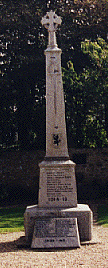 The War Memorial stands in a little garden in Victoria Street. On the pedestal is written “This site was a gift from Judge N.P. Le C. Barbenson L. en D. 1921”.
The War Memorial stands in a little garden in Victoria Street. On the pedestal is written “This site was a gift from Judge N.P. Le C. Barbenson L. en D. 1921”.
1914-1918
The names on the front panel are Louis Brochart, John Brochart, John L. Gamblin. Lieut., Alec George, Walter Last, Charles F. Price D.S.O., Thomas Lihou R.N., Charles Le Milliere R.N., Robert W. McLernon Lieut., Gustave Riou, Arthur Snaith.
On the left panel: William Christie Sergt., Desiré Pasquier, William Benwell, Harold Squires, Arthur Angel, John Bihet, Arsene Carry, Ernest R. Squires, Reginald Tinniswood R.N., Harold Bridle W.O., Frank Bideau, Alex Toussaint, Joseph Brady.
On the right panel: Arthur L. Hammond, Charles H. Hammond, Thomas Allen, William Bassett Sergt., Frederick Quinain S. Sergt., John N. Duplain, Edward Pippard, James Grier, H. Tupper Mellish Capt., John Barber R.N.R. Mid., Frank Pike, Arthur Hurst, M.M. Barney Lieut., Henry Johns.
On the rear panel: Edwin R. Underdown, Benjamin Walden, George Sharpe, Thomas Butler.
1939-1945
(leaning against the front pedestal on the ground)
Pearce Angel, Patrick Anson, Kenneth Bihet (corrected), James Bott, John Catts, George Caplain, William Clarke, John Cosheril (corrected), Harry Duce (corrected), Ronald Greenway, George Houguez, Charles Jennings, Alex McLean, Frank Mackey, Frank Miller, Bertram Millington, David Monteith, Leonard Napper, William Pike, Edmund Picot, Ronald Redhead, Roland Riou, John Rose (corrected), Geoffrey Workman.
On a plaque on the left hand side wall: Sapper George Onions, Royal Engineers, who gave his life on minefield clearing operations on Alderney 21st June 1945. In Grateful Remembrance.
